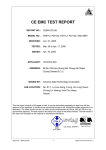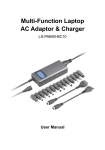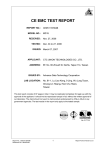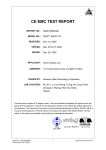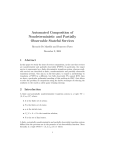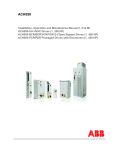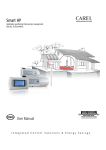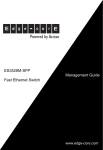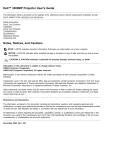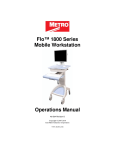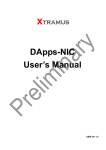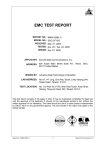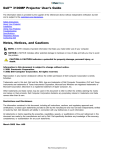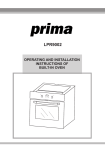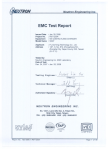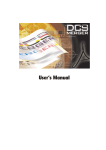Download CE EMC TEST REPORT
Transcript
CE EMC TEST REPORT REPORT NO. : CE951004H04F MODEL NO. : ES3528M-PoE RECEIVED : Oct. 04, 2006 TESTED : Oct. 05 to 17, 2006 ISSUED : Dec. 23, 2009 APPLICANT : Accton Technology Corporation ADDRESS : No. 1, Creation Rd. III, Science-based Industrial Park, Hsinchu, Taiwan, R.O.C. ISSUED BY : Bureau Veritas Consumer Products Services (H.K.) Ltd., Taoyuan Branch LAB LOCATION 1: No. 47, 14th Ling, Chia Pau Tsuen, Lin Kou Hsiang, Taipei Hsien 244, Taiwan LAB LOCATION 2: No. 81-1, Lu Liao Keng, 9 Ling, Wu Lung Tsuen, Chiung Lin Hsiang, Hsin Chu Hsien, Taiwan, R.O.C. This test report consists of 75 pages in total. It may be duplicated completely for legal use with the approval of the applicant. It should not be reproduced except in full, without the written approval of our laboratory. The client should not use it to claim product endorsement by TAF, NVLAP or any government agencies. The test results in the report only apply to the tested sample. The test results in this report are traceable to the national or international standards. Report No.: CE951004H04F Reference No.: 960130H03, 981222A14 1 Report Format Version 3.0.1 Table of Contents 1 2 2.1 3 3.1 3.2 3.3 3.4 4 4.1 4.1.1 4.1.2 4.1.3 4.1.4 4.1.5 4.1.6 4.1.7 4.2 4.2.1 4.2.2 4.2.3 4.2.4 4.2.5 4.2.6 4.2.7 4.2.8 4.2.9 4.3 4.3.1 4.3.2 4.3.3 4.3.4 4.3.5 4.3.6 4.3.7 4.4 4.4.1 4.4.2 4.4.3 4.4.4 4.4.5 4.4.6 4.5 4.5.1 CERTIFICATION ............................................................................................. 5 SUMMARY OF TEST RESULTS..................................................................... 6 MEASUREMENT UNCERTAINTY .................................................................. 7 GENERAL INFORMATION ............................................................................. 8 GENERAL DESCRIPTION OF EUT................................................................ 8 GENERAL DESCRIPTION OF TEST MODE .................................................. 9 GENERAL DESCRIPTION OF APPLIED STANDARDS ............................... 10 DESCRIPTION OF SUPPORT UNITS...........................................................11 EMISSION TEST........................................................................................... 14 CONDUCTED EMISSION MEASUREMENT ................................................ 14 LIMITS OF CONDUCTED EMISSION MEASUREMENT.............................. 14 TEST INSTRUMENTS .................................................................................. 14 TEST PROCEDURE ..................................................................................... 15 DEVIATION FROM TEST STANDARD ......................................................... 15 TEST SETUP ................................................................................................ 15 EUT OPERATING CONDITIONS .................................................................. 16 TEST RESULTS ............................................................................................ 17 CONDUCTED EMISSION MEASUREMENT AT TELECOMMUNICATION PORTS.......................................................................................................... 19 LIMIT OF CONDUCTED COMMON MODE DISTURBANCE AT TELECOMMUNICATION PORTS ................................................................. 19 TEST INSTRUMENTS .................................................................................. 20 TEST PROCEDURE ..................................................................................... 21 DEVIATION FROM TEST STANDARD ......................................................... 21 TEST SETUP ................................................................................................ 22 EUT OPERATING CONDITIONS .................................................................. 23 TEST RESULTS (MODE 1) ........................................................................... 24 TEST RESULTS (MODE 2) ........................................................................... 25 TEST RESULTS (MODE 3) ........................................................................... 26 RADIATED EMISSION MEASUREMENT ..................................................... 27 LIMITS OF RADIATED EMISSION MEASUREMENT................................... 27 TEST INSTRUMENTS .................................................................................. 27 TEST PROCEDURE ..................................................................................... 28 DEVIATION FROM TEST STANDARD ......................................................... 28 TEST SETUP ................................................................................................ 29 EUT OPERATING CONDITIONS .................................................................. 29 TEST RESULTS ............................................................................................ 30 HARMONICS CURRENT MEASUREMENT ................................................. 32 LIMITS OF HARMONICS CURRENT MEASUREMENT............................... 32 TEST INSTRUMENTS .................................................................................. 32 TEST PROCEDURE ..................................................................................... 33 TEST SETUP ................................................................................................ 33 EUT OPERATING CONDITIONS .................................................................. 34 TEST RESULTS ............................................................................................ 35 VOLTAGE FLUCTUATION AND FLICKER MEASUREMENT ....................... 36 LIMITS OF VOLTAGE FLUCTUATION AND FLICKER MEASUREMENT..... 36 Report No.: CE951004H04F Reference No.: 960130H03, 981222A14 2 Report Format Version 3.0.1 4.5.2 4.5.3 4.5.4 4.5.5 4.5.6 5 5.1 5.2 5.3 5.3.1 TEST INSTRUMENTS .................................................................................. 36 TEST PROCEDURE ..................................................................................... 36 TEST SETUP ................................................................................................ 37 EUT OPERATING CONDITIONS .................................................................. 37 TEST RESULTS ............................................................................................ 38 IMMUNITY TEST .......................................................................................... 39 GENERAL DESCRIPTION............................................................................ 39 GENERAL PERFORMANCE CRITERIA DESCRIPTION ............................. 40 PARTICULAR PERFORMANCE CRITERIA DESCRIPTION ........................ 41 PARTICULAR PERFORMANCE CRITERIA DESCRIPTION FOR LAN FUNCTION OF EUT...................................................................................... 41 5.4 EUT OPERATING CONDITION .................................................................... 41 5.5 ELECTROSTATIC DISCHARGE IMMUNITY TEST (ESD)............................ 42 5.5.1 TEST SPECIFICATION ................................................................................. 42 5.5.2 TEST INSTRUMENTS .................................................................................. 42 5.5.3 TEST PROCEDURE ..................................................................................... 42 5.5.4 TEST SETUP ................................................................................................ 44 5.5.5 TEST RESULTS ............................................................................................ 45 5.6 RADIATED, RADIO-FREQUENCY, ELECTROMAGNETIC FIELD IMMUNITY TEST (RS)..................................................................................................... 46 5.6.1 TEST SPECIFICATION ................................................................................. 46 5.6.2 TEST INSTRUMENTS .................................................................................. 46 5.6.3 TEST PROCEDURE ..................................................................................... 47 5.6.4 TEST SETUP ................................................................................................ 47 5.6.5 TEST RESULTS ............................................................................................ 48 5.7 ELECTRICAL FAST TRANSIENT/BURST IMMUNITY TEST (EFT) ............. 49 5.7.1 TEST SPECIFICATION ................................................................................. 49 5.7.2 TEST INSTRUMENTS .................................................................................. 49 5.7.3 TEST PROCEDURE ..................................................................................... 49 5.7.4 TEST SETUP ................................................................................................ 50 5.7.5 TEST RESULTS ............................................................................................ 51 5.8 SURGE IMMUNITY TEST............................................................................. 52 5.8.1 TEST SPECIFICATION ................................................................................. 52 5.8.2 TEST INSTRUMENTS .................................................................................. 52 5.8.3 TEST PROCEDURE ..................................................................................... 53 5.8.4 TEST SETUP ................................................................................................ 53 5.8.5 TEST RESULTS ............................................................................................ 54 5.9 IMMUNITY TO CONDUCTED DISTURBANCES INDUCED BY RF FIELDS (CS)............................................................................................................... 55 5.9.1 TEST SPECIFICATION ................................................................................. 55 5.9.2 TEST INSTRUMENTS .................................................................................. 55 5.9.3 TEST PROCEDURE ..................................................................................... 56 5.9.4 TEST SETUP ................................................................................................ 56 5.9.5 TEST RESULTS ............................................................................................ 57 5.10 POWER FREQUENCY MAGNETIC FIELD IMMUNITY TEST...................... 58 5.10.1 TEST SPECIFICATION ................................................................................. 58 5.10.2 TEST INSTRUMENTS .................................................................................. 58 Report No.: CE951004H04F Reference No.: 960130H03, 981222A14 3 Report Format Version 3.0.1 5.10.3 5.10.4 5.10.5 5.11 5.11.1 5.11.2 5.11.3 5.11.4 5.11.5 6 7 TEST PROCEDURE ..................................................................................... 58 TEST SETUP ................................................................................................ 59 TEST RESULTS ............................................................................................ 60 VOLTAGE DIP/SHORT INTERRUPTIONS/VOLTAGE VARIATIONS (DIP) IMMUNITY TEST .......................................................................................... 61 TEST SPECIFICATION ................................................................................. 61 TEST INSTRUMENTS .................................................................................. 61 TEST PROCEDURE ..................................................................................... 61 TEST SETUP ................................................................................................ 62 TEST RESULTS ............................................................................................ 63 PHOTOGRAPHS OF THE TEST CONFIGURATION.................................... 64 APPENDIX - INFORMATION ON THE TESTING LABORATORIES............. 75 Report No.: CE951004H04F Reference No.: 960130H03, 981222A14 4 Report Format Version 3.0.1 1 CERTIFICATION PRODUCT: BRAND NAME: MODEL NO: TESTED: TEST ITEM: APPLICANT: STANDARDS: Fast Ethernet Switch Edge-Core ES3528M-PoE Oct. 05 to 17, 2006 R&D SAMPLE Accton Technology Corporation EN 55022:1998+A1:2000 +A2:2003, Class A EN 61000-3-2: 2000, Class A EN 61000-3-3: 1995+A1: 2001 EN 55024:1998+A1:2001 +A2:2003 IEC 61000-4-2:2001 IEC 61000-4-3:2002+A1:2002 IEC 61000-4-4:2004 IEC 61000-4-5:2001 IEC 61000-4-6:2003+A1:2004 IEC 61000-4-8:2001 IEC 61000-4-11:2004 The above equipment has been tested by Bureau Veritas Consumer Products Services (H.K.) Ltd., Taoyuan Branch, and found compliance with the requirement of the above standards. The test record, data evaluation & Equipment Under Test (EUT) configurations represented herein are true and accurate accounts of the measurements of the sample’s EMC characteristics under the conditions specified in this report. PREPARED BY : , DATE: Dec. 23, 2009 , DATE: Dec. 23, 2009 , DATE: Dec. 23, 2009 ( Jessica Cheng / Specialist ) TECHNICAL ACCEPTANCE : (Joyce Chen / Senior Engineer) APPROVED BY : (Kenny Meng / Assistant Manager) Report No.: CE951004H04F Reference No.: 960130H03, 981222A14 5 Report Format Version 3.0.1 2 SUMMARY OF TEST RESULTS The EUT has been tested according to the following specifications: EMISSION Test Type Result Standard EN 55022:1998 +A1:2000+A2:2003, Class A EN 61000-3-2:2000, Class A EN 61000-3-3:1995 + A1:2001 Conducted Test PASS Telecommunication Ports Conducted Test PASS Radiated Test PASS Harmonic current emissions Voltage fluctuations & flicker Remarks Meets Class A Limit Minimum passing margin is -19.26 dB at 0.615 MHz Meets Class A Limit Minimum passing margin is -3.63 dB at 0.312 MHz Meets Class A Limit Minimum passing margin is -9.3 dB at 143.40 MHz PASS Meets Class A Limit PASS Meets the requirements. IMMUNITY (EN 55024:1998+A1:2001+A2:2003) Standard Test Type Result Remarks Electrostatic discharge immunity test Radiated, IEC 61000-4-3: 2002 radio-frequency, electromagnetic field +A1:2002 immunity test Electrical fast transient IEC 61000-4-4: 2004 / burst immunity test. IEC 61000-4-2: 2001 IEC 61000-4-5: 2001 Surge immunity test Immunity to conducted IEC 61000-4-6: 2003 disturbances, induced by radio-frequency +A1:2004 fields Power frequency IEC 61000-4-8: 2001 magnetic field immunity test. Voltage dips, short interruptions and IEC 61000-4-11:2004 voltage variations immunity tests Report No.: CE951004H04F Reference No.: 960130H03, 981222A14 6 PASS Meets the requirements of Performance Criterion A PASS Meets the requirements of Performance Criterion A PASS PASS Meets the requirements of Performance Criterion A Meets the requirements of Performance Criterion A PASS Meets the requirements of Performance Criterion A PASS Meets the requirements of Performance Criterion A PASS Meets the requirements of Voltage Dips: 1. >95% reduction Performance Criterion A 2. 30% reduction Performance Criterion A Voltage Interruptions: 1. >95% reduction Performance Criterion B Report Format Version 3.0.1 2.1 MEASUREMENT UNCERTAINTY Where relevant, the following measurement uncertainty levels have been estimated for tests performed on the EUT as specified in CISPR 16-4-2: This uncertainty represents an expanded uncertainty expressed at approximately the 95% confidence level using a coverage factor of k=2. MEASUREMENT Conducted emissions UNCERTAINTY 2.53 dB Radiated emissions 3.30 dB Report No.: CE951004H04F Reference No.: 960130H03, 981222A14 7 Report Format Version 3.0.1 3 GENERAL INFORMATION 3.1 GENERAL DESCRIPTION OF EUT PRODUCT MODEL NO. POWER SUPPLY POWER CORD DATA CABLE SUPPLIED I/O PORT Fast Ethernet Switch ES3528M-PoE Internal power supply, Class I NA DB9 cable (Unshielded, 1.6m) RJ45 Port x 24 (10/100Mbps with POE function) RJ45 Port x 4 (10/100/1000Mbps with POE function) Giga Combo (RJ45/miniGBIC) Ports x 2 Console Port x 1 NOTE: 1. This report is base on ADT report with Reference No.: CE951004H04A. The original report was issued by Advance Data Technology Corp. (ADT Corp.) on Feb. 01, 2007. ADT Corp. is one of Bureau Veritas family and she has fully transferred all its test facilities, staffs & service system to Bureau Veritas Consumer Products Services (Hong Kong) Limited, Taoyuan Branch in 2008. 2. The EUT was pre-tested under following test mode, and the test data was recorded in this report: Conducted and Radiated emission Pre-test Mode Description Mode A Port 1 10 Mbps + Port 28 10 Mbps Mode B Port 1 100 Mbps + Port 28 100 Mbps Mode C Port 1 100 Mbps + Port 28 1000 Mbps Telecommunication ports conducted test Pre-test Mode Description Mode D 10 Mbps Mode E 100 Mbps The worst conducted and radiated emission was found in Mode C. The worst Telecommunication ports conducted test was found in Mode D. The final test was executed under test mode with highest emission and recorded in this report individually. Report No.: CE951004H04F Reference No.: 960130H03, 981222A14 8 Report Format Version 3.0.1 3. For a more detailed features description, please refer to the manufacturer's specifications or the User's Manual. 3.2 GENERAL DESCRIPTION OF TEST MODE The EUT was tested under following test modes : For Conducted and Radiated test Test Mode Description Mode 1 Port 1 100 Mbps + Port 28 1000 Mbps For Telecommunication ports conducted test Test Mode Description Mode 1 10 Mbps Mode 2 1000 Mbps (Current) Mode 3 1000 Mbps (Voltage) Harmonics Current / Voltage Fluctuation and Flicker / Immunity test Test Mode Mode 1 Description Port 1 100 Mbps + Port 28 1000 Mbps Report No.: CE951004H04F Reference No.: 960130H03, 981222A14 9 Report Format Version 3.0.1 3.3 GENERAL DESCRIPTION OF APPLIED STANDARDS The EUT is a kind of IT equipment and, according to the specifications of the manufacturers, must comply with the requirements of the following standards: EN 55022:1998+A1:2000+A2:2003, Class A EN 61000-3-2: 2000, Class A EN 61000-3-3: 1995+A1: 2001 EN 55024:1998+A1:2001+A2:2003 IEC 61000-4-2:2001 IEC 61000-4-3:2002+A1:2002 IEC 61000-4-4:2004 IEC 61000-4-5:2001 IEC 61000-4-6:2003+A1:2004 IEC 61000-4-8:2001 IEC 61000-4-11:2004 All tests have been performed and recorded as per the above standards. Report No.: CE951004H04F Reference No.: 960130H03, 981222A14 10 Report Format Version 3.0.1 3.4 DESCRIPTION OF SUPPORT UNITS The EUT has been tested as an independent unit together with other necessary accessories or support units. The following support units or accessories were used to form a representative test configuration during the tests. FOR CONDUCTED & RADIATED TEST ITEMS: No. Product 1 Nustreams Brand Xtramus NuStreams-600 05NS06C00004 FCC ID DoC 2 PERSONAL COMPUTER DELL DCSM 294QL1S DoC 3 MONITOR ADI CM100 026058T10200636 A DoC 4 KEYBOARD BTC KB-5200T F24800403 E5XKB5122WTH0110 5 MOUSE BTC Mid Span PoE Test hp 6 M851 5092-0764 G00347024434 NA DoC DoC 7 Gigabit Switch SMC6128PL2 NA NA No. 1 2 3 4 5 6 7 SMC Model No. Serial No. Signal cable description NA NA 1.8 m braid shielded wire, terminated with VGA connector via metallic frame, w/o core 1.7 m foil shielded wire, terminated with PS/2 connector via metallic frame, w/o core 1.5 m foil shielded wire, terminated with PS/2 connector via metallic frame, w/o core NA NA FOR HARMONICS CURRENT / VOLTAGE FLUCTUATION AND FLICKER / IMMUNITY TEST: No. Product 1 NOTEBBOK COMPUTER Brand Model No. Serial No. FCC ID DELL PPT 17044664176 E2K24GBRL 5092-0764 NA NA 2 Mid Span PoE Test hp 3 NOTEBBOK COMPUTER HP 4 Mid Span PoE Test hp HSTNN-S19C 5029-0764 GFC2Q-3C9FD-QXCY T-YTB2D-BJH43 NA NA NA No. Signal cable description 1 NA 2 NA 3 NA 4 NA Note: 1. All power cords of the above support units are unshielded (1.8m). Report No.: CE951004H04F Reference No.: 960130H03, 981222A14 11 Report Format Version 3.0.1 FOR CONDUCTED & RADIATED TEST ITEMS: RS232 cable (1.8m) EUT Fiber cable (1m) cat.3 cable (10m, 10Mbps) x 11 UTP cable (10m) x 13 UTP cable (10m) x 15 TEST TABLE 6. Mid Span PoE Test 7. Gigabit Switch (SMC6128PL2) 1. Nustreams 2. PC 3. MONITOR 4. KEYBOARD 5. MOUSE NOTE: 1. Support units 1-7 were kept in the control room during the test. 2. The test configuration of radiated emission used overhead rack. Please refer to the photos of test configuration in Item 6 also. Report No.: CE951004H04F Reference No.: 960130H03, 981222A14 12 Report Format Version 3.0.1 FOR HARMONICS CURRENT / VOLTAGE FLUCTUATION AND FLICKER / IMMUNITY TEST: RS232 cable (1.8m) EUT TEST TABLE UTP Cable (10m) (Port 1 100 Mbps) UTP Cable (10m) (Port 28 1000 Mbps) UTP Cable (10m) x 6 1. NOTEBBOK COMPUTER 3. NOTEBBOK COMPUTER 2. Mid Span PoE Test 4. Mid Span PoE Test CONTROL ROOM NOTE: 1. Support units 1-4 were kept in the control room during the test. 2. Please refer to the photos of test configuration in Item 6 also. Report No.: CE951004H04F Reference No.: 960130H03, 981222A14 13 Report Format Version 3.0.1 4 EMISSION TEST 4.1 CONDUCTED EMISSION MEASUREMENT 4.1.1 LIMITS OF CONDUCTED EMISSION MEASUREMENT TEST STANDARD: EN 55022 FREQUENCY (MHz) 0.15 - 0.5 0.50 - 5.0 5.0 - 30.0 NOTE: Class A (dBuV) Quasi-peak Average 79 66 73 60 73 60 Class B (dBuV) Quasi-peak Average 66 - 56 56 - 46 56 46 60 50 (1) The lower limit shall apply at the transition frequencies. (2) The limit decreases in line with the logarithm of the frequency in the range of 0.15 to 0.50 MHz. (3) All emanations from a class A/B digital device or system, including any network of conductors and apparatus connected thereto, shall not exceed the level of field strengths specified above. 4.1.2 TEST INSTRUMENTS DESCRIPTION & MANUFACTURER MODEL NO. SERIAL NO. CALIBRATED UNTIL ROHDE & SCHWARZ Test Receiver ESCS 30 100287 Feb. 10, 2007 Line-Impedance Stabilization Network(for EUT) ESH3-Z5 848773/004 Oct. 24, 2006 Line-Impedance Stabilization Network(for Peripheral) ENV-216 100072 Oct. 24, 2006 RF Cable (JETBAO) RG233/U Cable_CA_01 Jul. 19, 2007 50 1 Oct. 08, 2007 ADT_Cond_V7.3.2 NA NA Terminator Software NOTE: 1. The calibration interval of the above test instruments is 12 months and the calibrations are traceable to NML/ROC and NIST/USA. 2. The test was performed in ADT Shielded Room No. A. 3. The VCCI Con A Registration No. is C-817. Report No.: CE951004H04F Reference No.: 960130H03, 981222A14 14 Report Format Version 3.0.1 4.1.3 TEST PROCEDURE a. The EUT was placed 0.4 meters from the conducting wall of the shielded room with EUT being connected to the power mains through a line impedance stabilization network (LISN). Other support units were connected to the power mains through another LISN. The two LISNs provide 50 Ohm/ 50uH of coupling impedance for the measuring instrument. b. Both lines of the power mains connected to the EUT were checked for maximum conducted interference. c. The frequency range from 150 kHz to 30 MHz was searched. Emission levels over 10dB under the prescribed limits could not be reported. 4.1.4 DEVIATION FROM TEST STANDARD No deviation 4.1.5 TEST SETUP Ve r tic a l R e f e r e n c e T e s t R e c e iv e r G r o u n d P la n e 40cm EUT 80cm L IS N H o r iz o n ta l R e fe r e n c e G r o u n d P la n e N o te : 1 .S u p p o r t u n its w e r e c o n n e c te d to s e c o n d L IS N . 2 .B o th o f L IS N s ( A M N ) a r e 8 0 c m fr o m E U T a n d a t le a s t 8 0 fr o m o th e r u n its a n d o th e r m e ta l p la n e s For the actual test configuration, please refer to the related item – Photographs of the Test Configuration. Report No.: CE951004H04F Reference No.: 960130H03, 981222A14 15 Report Format Version 3.0.1 4.1.6 EUT OPERATING CONDITIONS 1. Turn on the power of all equipment. 2. Support unit 2(PC) run “Nustreams” test program to enable all functions of EUT via Support unit 1(Nustreams) and support unit 6. 3. Support unit 7 (Giga switch) transmitted messages to and received messages via EUT. 4. Repeat steps 2-3. Report No.: CE951004H04F Reference No.: 960130H03, 981222A14 16 Report Format Version 3.0.1 4.1.7 TEST RESULTS TEST MODE Mode 1 6dB BANDWIDTH 9 kHz INPUT POWER (SYSTEM) 230Vac, 50 Hz PHASE Line (L) TESTED BY Max Tseng ENVIRONMENTAL 25 deg. C, 60 % RH, CONDITIONS 968 hPa Freq. Corr. Reading Value [MHz] 0.177 0.439 0.615 0.705 18.181 29.063 Factor (dB) 0.42 0.30 0.30 0.30 0.86 1.00 [dB (uV)] Q.P. AV. 47.58 45.26 45.27 37.31 47.28 40.44 46.04 40.36 44.81 37.84 46.35 37.09 No 1 2 3 4 5 6 Emission Level [dB (uV)] Q.P. AV. 48.00 45.68 45.57 37.61 47.58 40.74 46.34 40.66 45.67 38.70 47.35 38.09 Limit Margin [dB (uV)] Q.P. AV. 79.00 66.00 79.00 66.00 73.00 60.00 73.00 60.00 73.00 60.00 73.00 60.00 (dB) Q.P. AV. -31.00 -20.32 -33.43 -28.39 -25.42 -19.26 -26.66 -19.34 -27.33 -21.30 -25.65 -21.91 REMARKS: 1. Q.P. and AV. are abbreviations of quasi-peak and average individually. 2. "-": The Quasi-peak reading value also meets average limit and measurement with the average detector is unnecessary. 3. The emission levels of other frequencies were very low against the limit. 4. Margin value = Emission level - Limit value 5. Correction factor = Insertion loss + Cable loss 6. Emission Level = Correction Factor + Reading Value. Report No.: CE951004H04F Reference No.: 960130H03, 981222A14 17 Report Format Version 3.0.1 TEST MODE Mode 1 6dB BANDWIDTH 9 kHz INPUT POWER (SYSTEM) 230Vac, 50 Hz PHASE Neutral (N) TESTED BY Max Tseng ENVIRONMENTAL 25 deg. C, 60 % RH, CONDITIONS 968 hPa Freq. Corr. Reading Value [MHz] 0.177 0.615 0.705 1.142 19.167 27.332 Factor (dB) 0.42 0.34 0.35 0.40 0.88 1.00 [dB (uV)] Q.P. AV. 46.91 44.26 45.71 38.88 44.57 38.71 40.23 33.62 42.28 34.09 41.39 27.65 No 1 2 3 4 5 6 Emission Level [dB (uV)] Q.P. AV. 47.33 44.68 46.05 39.22 44.92 39.06 40.63 34.02 43.16 34.97 42.39 28.65 Limit Margin [dB (uV)] Q.P. AV. 79.00 66.00 73.00 60.00 73.00 60.00 73.00 60.00 73.00 60.00 73.00 60.00 (dB) Q.P. AV. -31.67 -21.32 -26.95 -20.78 -28.08 -20.94 -32.37 -25.98 -29.84 -25.03 -30.61 -31.35 REMARKS: 1. Q.P. and AV. are abbreviations of quasi-peak and average individually. 2. "-": The Quasi-peak reading value also meets average limit and measurement with the average detector is unnecessary. 3. The emission levels of other frequencies were very low against the limit. 4. Margin value = Emission level - Limit value 5. Correction factor = Insertion loss + Cable loss 6. Emission Level = Correction Factor + Reading Value. Report No.: CE951004H04F Reference No.: 960130H03, 981222A14 18 Report Format Version 3.0.1 4.2 CONDUCTED EMISSION MEASUREMENT AT TELECOMMUNICATION PORTS 4.2.1 LIMIT OF CONDUCTED COMMON MODE DISTURBANCE AT TELECOMMUNICATION PORTS TEST STANDARD: EN 55022 FOR CLASS A EQUIPMENT FREQUENCY Voltage Limit (dBuV) Current Limit (dBuA) (MHz) Quasi-peak Average Quasi-peak Average 0.15 - 0.5 97 – 87 84 - 74 53 – 43 40 – 30 0.5 - 30.0 87 74 43 30 FOR CLASS B EQUIPMENT FREQUENCY Voltage Limit (dBuV) Current Limit (dBuA) (MHz) Quasi-peak Average Quasi-peak Average 0.15 - 0.5 84 - 74 74 - 64 40 – 30 30 – 20 0.5 - 30.0 74 64 30 20 NOTE: (1) The limits decrease linearly with the logarithm of the frequency in the range 0.15 MHz to 0.5 MHz. Report No.: CE951004H04F Reference No.: 960130H03, 981222A14 19 Report Format Version 3.0.1 4.2.2 TEST INSTRUMENTS DESCRIPTION & MANUFACTURER MODEL NO. SERIAL NO. CALIBRATED UNTIL ROHDE & SCHWARZ Test Receiver ESCS 30 100287 Feb. 10, 2007 Line-Impedance Stabilization Network(for EUT) ESH3-Z5 848773/004 Oct. 24, 2006 Line-Impedance Stabilization Network(for Peripheral) ENV-216 100072 Oct. 24, 2006 ROHDE & SCHWARZ ISN ENY 41 838119/024 Feb. 24, 2007 ROHDE & SCHWARZ ISN ENY 22 837497/019 Feb. 24, 2007 RF Cable (JETBAO) RG233/U Cable_CA_01 Jul. 18, 2007 CURRENT PROBE SMZ 11 18001 Jul. 25, 2007 F-35 455 Jul. 04, 2007 CVP 2200 18312 Jul. 25, 2007 RF Current Probe Capacitive Voltage Probe RF- ABSORBING CLAMP KEMA 801 16617 NA NOTE: 1. The calibration interval of the above test instruments is 12 months and the calibrations are traceable to NML/ROC and NIST/USA. 2. The test was performed in ADT Shielded Room No. A. 3. The VCCI Con A Registration No. is C-817. Report No.: CE951004H04F Reference No.: 960130H03, 981222A14 20 Report Format Version 3.0.1 4.2.3 TEST PROCEDURE For ISN: a. The EUT was placed 0.4 meters from the conducting wall of the shielded room and connected to the power mains through a line impedance stabilization network (LISN). Other support units were connected to the power mains through another LISN. b. Voltage at the measurement port of the ISN was detected, the reading was corrected by adding the voltage division factor of the ISN, and was compared to the voltage limits. c. The disturbance levels and the frequencies of at least six highest disturbances were recorded from each telecommunication port, which comprises the EUT. For Current Probe: a. Current probe shall be placed at 0.1m from the ISN. b. Current at the measurement port of the ISN was detected, the reading was corrected by adding the current division factor of the current probe, and was compared to the current limits. c. The disturbance levels and the frequencies of at least six highest disturbances were recorded from each telecommunication port, which comprises the EUT. For Voltage Probe: a. The EUT was placed 0.4 meters from the conducting wall of the shielded room and connected to the power mains through a line impedance stabilization network (LISN). Other support units were connected to the power mains through another LISN. b. Voltage at the measurement port of the voltage probe was detected, the reading was corrected by adding the voltage division factor of the voltage probe, and was compared to the voltage limits. c. The disturbance levels and the frequencies of at least six highest disturbances were recorded from each telecommunication port, which comprises the EUT. 4.2.4 DEVIATION FROM TEST STANDARD No deviation Report No.: CE951004H04F Reference No.: 960130H03, 981222A14 21 Report Format Version 3.0.1 4.2.5 TEST SETUP For ISN Probe: Vertical R eference Tes t R eceiver Ground Plane EU T 40cm 80cm ISN AE H orizontal R eference Ground Plane N ote: 1. Support units w ere connected to second LISN . 2. Both of LISNs (AMN ) and ISN are 80 cm from EU T and at leas t 80 cm from other units and other metal planes s upport units . For Voltage & Current Probe: For the actual test configuration, please refer to the related item – Photographs of the Test Configuration. Report No.: CE951004H04F Reference No.: 960130H03, 981222A14 22 Report Format Version 3.0.1 NOTE: 1. The methods of conformance testing were selected according to the Alternative 1 (EN 55022: 1998, section: 9.5.1.1) or Alternative 2 (EN 55022: 1998, section: 9.5.1.2) of measurement method using an ISN with a longitudinal conversion loss (LCL) as defined in rule. 2. When measurements were performed on a single unscreened balanced pair, an adequate ISN for two wires were used; when performed on unscreened cables containing two balanced pairs, an adequate ISN for four wires were used. 3. The communication function of EUT was executed and ISN was connected between EUT and associated equipment and the ISN was connected directly to reference ground plane. 4.2.6 EUT OPERATING CONDITIONS Same as item 4.1.6. Report No.: CE951004H04F Reference No.: 960130H03, 981222A14 23 Report Format Version 3.0.1 4.2.7 TEST RESULTS (MODE 1) TEST MODE Mode 1 RJ45 Telecom Port TELECOM PORT ENVIRONMENTAL CONDITIONS REMARKS: 25 deg. C, 60% RH, 968 hPa Freq. Corr. [MHz] 0.168 0.252 0.420 8.090 9.414 10.582 Factor (dB) 10.38 10.36 10.32 10.28 10.31 10.32 No 1 2 3 4 5 6 (10Mbps) Reading Value [dB (uV)] Q.P. AV. 69.92 68.88 62.88 62.77 56.67 56.57 58.34 47.86 61.07 50.70 60.13 49.53 INPUT POWER 230Vac, 50 Hz 6dB BANDWIDTH 9 kHz TESTED BY Max Tseng Emission Level [dB (uV)] Q.P. AV. 80.30 79.26 73.24 73.13 66.99 66.89 68.62 58.14 71.38 61.01 70.45 59.85 Limit Margin [dB (uV)] A.V. Q.P. 83.05 96.05 79.71 92.71 75.46 88.46 74.00 87.00 74.00 87.00 74.00 87.00 (dB) Q.P. A.V. -15.75 -3.79 -19.47 -6.58 -21.47 -8.57 -18.38 -15.86 -15.62 -12.99 -16.55 -14.15 1. Q.P. and AV. are abbreviations of quasi-peak and average individually. 2. "-": The Quasi-peak reading value also meets average limit and measurement with the average detector is unnecessary. 3. The emission levels of other frequencies were very low against the limit. 4. Margin value = Emission level - Limit value 5. Correction factor = Insertion loss + Cable loss 6. Emission Level = Correction Factor + Reading Value. Report No.: CE951004H04F Reference No.: 960130H03, 981222A14 24 Report Format Version 3.0.1 4.2.8 TEST RESULTS (MODE 2) TEST MODE Mode 2 INPUT POWER 230Vac, 50 Hz TELECOM PORT 1000Mbps (Current) 6dB BANDWIDTH 9 kHz ENVIRONMENTAL CONDITIONS 25 deg. C, 60% RH, 968 hPa TESTED BY Max Tseng Freq. Corr. [MHz] 0.254 0.388 0.513 0.720 2.626 10.629 Factor (dB) -0.41 -0.08 -0.02 0.04 0.26 0.40 No 1 2 3 4 5 6 REMARKS: Reading Emission Level Value [dB (uA)] [dB (uA)] Q.P. AV. Q.P. AV. 34.34 30.31 33.93 29.90 10.05 6.44 9.97 6.36 17.19 14.65 17.17 14.63 10.80 4.97 10.84 5.01 8.13 6.55 8.39 6.81 10.13 9.53 10.53 9.93 Limit Margin [dB (uA)] Q.P. A.V. 48.62 35.62 32.10 45.10 43.00 30.00 43.00 30.00 30.00 43.00 43.00 30.00 (dB) Q.P. A.V. -14.69 -5.72 -35.13 -25.74 -25.83 -15.37 -32.16 -24.99 -34.61 -23.19 -32.47 -20.07 1. Q.P. and AV. are abbreviations of quasi-peak and average individually. 2. "-": The Quasi-peak reading value also meets average limit and measurement with the average detector is unnecessary. 3. The emission levels of other frequencies were very low against the limit. 4. Margin value = Emission level - Limit value 5. Correction factor = Insertion loss + Cable loss 6. Emission Level = Correction Factor + Reading Value. Report No.: CE951004H04F Reference No.: 960130H03, 981222A14 25 Report Format Version 3.0.1 4.2.9 TEST RESULTS (MODE 3) TEST MODE Mode 3 INPUT POWER 230Vac, 50 Hz TELECOM PORT 1000Mbps (Voltage) 6dB BANDWIDTH 9 kHz ENVIRONMENTAL CONDITIONS 25 deg. C, 60% RH, 968 hPa TESTED BY Max Tseng Freq. Corr. [MHz] 0.170 0.213 0.252 0.312 1.252 7.473 Factor (dB) 42.94 42.94 42.94 42.93 42.93 43.12 No 1 2 3 4 5 6 REMARKS: Reading Emission Level Value [dB (uV)] [dB (uV)] Q.P. AV. Q.P. AV. 34.86 34.49 77.80 77.43 19.37 15.71 62.31 58.65 24.98 21.49 67.92 64.43 33.21 31.35 76.14 74.28 13.20 11.51 56.13 54.44 11.18 10.95 54.30 54.07 Limit Margin [dB (uV)] A.V. Q.P. 82.98 95.98 81.11 94.11 79.71 92.71 77.91 90.91 74.00 87.00 74.00 87.00 (dB) Q.P. A.V. -18.18 -5.55 -31.80 -22.46 -24.79 -15.28 -14.77 -3.63 -30.87 -19.56 -32.70 -19.93 1. Q.P. and AV. are abbreviations of quasi-peak and average individually. 2. "-": The Quasi-peak reading value also meets average limit and measurement with the average detector is unnecessary. 3. The emission levels of other frequencies were very low against the limit. 4. Margin value = Emission level - Limit value 5. Correction factor = Insertion loss + Cable loss 6. Emission Level = Correction Factor + Reading Value. Report No.: CE951004H04F Reference No.: 960130H03, 981222A14 26 Report Format Version 3.0.1 4.3 RADIATED EMISSION MEASUREMENT 4.3.1 LIMITS OF RADIATED EMISSION MEASUREMENT TEST STANDARD: EN 55022 Class A (at 10m) dBuV/m 40 47 FREQUENCY (MHz) 30 - 230 230 - 1000 NOTE: Class B (at 10m) dBuV/m 30 37 (1) The lower limit shall apply at the transition frequencies. (2) Emission level (dBuV/m) = 20 log Emission level (uV/m). (3) All emanations from a class A/B digital device or system, including any network of conductors and apparatus connected thereto, shall not exceed the level of field strengths specified above. 4.3.2 TEST INSTRUMENTS DESCRIPTION & MANUFACTURER *ADVANTEST Spectrum Analyzer *HP Pre_Amplifier *ROHDE & SCHWARZ Test Receiver *CHASE Broadband Antenna *Schwarzbeck Horn_Antenna Schwarzbeck Horn_Antenna SCHWARZBECK Biconical Antenna SCHWARZBECK Periodic Antenna *RF Switches MODEL NO. SERIAL NO. R3271A 8449B 85060311 3008A01922 CALIBRATED UNTIL July 03, 2007 Oct. 02, 2007 ESCS 30 100027 Jul. 26, 2007 CBL6112B BBHA9120 2798 D123 BBHA917015 3 Dec. 11, 2006 Sep. 23, 2007 VHBA9123 459 Jun. 08, 2009 UPA6108 1148 Jun. 08, 2009 BBHA 9170 Jan. 05, 2007 M50867 July 03, 2007 STACAB-30M*RF Cable(JETBAO) 9913-30M N-N Cable July 17, 2007 1GHz *Software ADT_Radiated_V5.14 NA NA *EMCO Antenna Tower 2075-2 9712-2124 NA *EMCO Turn Table 2081-1.53 9712-2030 NA *CORCOM AC Filter MRI2030 107/108 NA *Ferrite Clamp FC18 910094 Dec. 01, 2006 *Ferrite Clamp FC18 910095 Dec. 01, 2006 *Ferrite Clamp FC18 910096 Dec. 01, 2006 Note: 1. The calibration interval of the above test instruments is 12 months (36 months for Periodic Antenna) and the calibrations are traceable to NML/ROC and NIST/USA. 2. * = These equipment are used for the final measurement. 3. The horn antenna, HP preamplifier (model: 8449B) and Spectrum Analyzer (model: R3271A) are used only for the measurement of emission frequency above 1GHz if tested. 4. The test was performed in ADT Open Site No. A. 5. The VCCI Site Registration No. is R-782. 6. The FCC Site Registration No. is 91097. 7. The CANADA Site Registration No. is IC 4824-1. Report No.: CE951004H04F Reference No.: 960130H03, 981222A14 MP59B 27 Report Format Version 3.0.1 4.3.3 TEST PROCEDURE a. The EUT was placed on the top of a rotating table 0.8 meters above the ground at a 10-meter open field site. The table was rotated 360 degrees to determine the position of the highest radiation. b. The EUT was set 10 meters away from the interference-receiving antenna, which was mounted on the top of a variable-height antenna tower. c. The antenna is a broadband antenna, and its height is varied from one meter to four meters above the ground to determine the maximum value of the field strength. Both horizontal and vertical polarization of the antenna are set to make the measurement. d. For each suspected emission, the EUT was arranged to its worst case and then the antenna was tuned to heights from 1 meter to 4 meters and the turn table was turned from 0 degrees to 360 degrees to find the maximum reading. e. The test-receiver system was set to Peak Detect Function and Specified Bandwidth with Maximum Hold Mode. f. If the emission level of the EUT in peak mode was 10 dB lower than the limit specified, then testing could be stopped and the peak values of the EUT would be reported. Otherwise the emissions that did not have 10 dB margin would be re-tested one by one using the quasi- peak method or average method as specified and then reported In Data sheet peak mode and QP mode. 4.3.4 DEVIATION FROM TEST STANDARD No deviation Report No.: CE951004H04F Reference No.: 960130H03, 981222A14 28 Report Format Version 3.0.1 4.3.5 TEST SETUP Ant. Tower EUT& Support Units 1-4m Variable 10m Turn Table 80cm Ground Plane Test Receiver For the actual test configuration, please refer to the related item – Photographs of the Test Configuration. 4.3.6 EUT OPERATING CONDITIONS Same as 4.1.6 Report No.: CE951004H04F Reference No.: 960130H03, 981222A14 29 Report Format Version 3.0.1 4.3.7 TEST RESULTS TEST MODE Mode 1 FREQUENCY RANGE 30-1000 MHz INPUT POWER (SYSTEM) 230Vac, 50 Hz DETECTOR FUNCTION & BANDWIDTH ENVIRONMENTAL CONDITIONS 21 deg. C, 70% RH, 968 hPa TESTED BY : Timmy Hu Quasi-Peak, 120kHz ANTENNA POLARITY & TEST DISTANCE: HORIZONTAL AT 10 M No. Freq. (MHz) 1 2 3 4 5 6 7 8 9 10 124.92 142.27 224.95 250.15 375.00 500.00 600.01 750.01 800.01 1000.01 REMARKS: Emission Level (dBuV/m) 26.30 QP 29.40 QP 26.70 QP 32.20 QP 33.60 QP 33.30 QP 35.00 QP 32.60 QP 31.00 QP 34.20 QP Limit (dBuV/m) Margin (dB) 40.00 40.00 40.00 47.00 47.00 47.00 47.00 47.00 47.00 47.00 -13.70 -10.60 -13.30 -14.80 -13.40 -13.70 -12.00 -14.40 -16.00 -12.80 Antenna Height (m) 3.99 H 3.99 H 3.99 H 3.99 H 2.91 H 2.01 H 1.58 H 1.34 H 1.00 H 1.00 H Table Angle (Degree) 186 205 185 93 262 236 108 19 301 207 Raw Value (dBuV) 14.00 17.10 14.30 18.40 15.80 12.90 12.90 8.20 6.40 7.80 Correction Factor (dB/m) 12.30 12.40 12.50 13.80 17.80 20.40 22.10 24.30 24.60 26.50 1. Emission level(dBuV/m)=Raw Value(dBuV) + Correction Factor(dB/m) 2. Correction Factor(dB/m) = Antenna Factor (dB/m) + Cable Factor (dB) 3. The other emission levels were very low against the limit. 4. Margin value = Emission level – Limit value. Report No.: CE951004H04F Reference No.: 960130H03, 981222A14 30 Report Format Version 3.0.1 TEST MODE Mode 1 FREQUENCY RANGE 30-1000 MHz INPUT POWER (SYSTEM) 230Vac, 50 Hz DETECTOR FUNCTION & BANDWIDTH ENVIRONMENTAL CONDITIONS 21 deg. C, 70% RH, 968 hPa TESTED BY : Timmy Hu Quasi-Peak, 120kHz ANTENNA POLARITY & TEST DISTANCE: VERTICAL AT 10 M No. Freq. (MHz) 1 2 3 4 5 6 7 8 9 10 125.68 143.40 225.00 250.00 375.00 500.00 600.01 750.01 800.01 1000.01 REMARKS: Emission Level (dBuV/m) 25.10 QP 30.70 QP 22.60 QP 31.90 QP 32.90 QP 33.90 QP 34.60 QP 29.10 QP 30.10 QP 31.40 QP Limit (dBuV/m) Margin (dB) 40.00 40.00 40.00 47.00 47.00 47.00 47.00 47.00 47.00 47.00 -14.90 -9.30 -17.40 -15.10 -14.10 -13.10 -12.40 -17.90 -16.90 -15.60 Antenna Height (m) 1.00 V 1.00 V 1.00 V 1.00 V 1.00 V 1.00 V 2.66 V 2.29 V 2.04 V 1.93 V Table Angle (Degree) 320 263 19 349 56 140 349 217 299 101 Raw Value (dBuV) 12.80 18.50 10.10 18.20 15.10 13.60 12.50 4.80 5.50 5.00 Correction Factor (dB/m) 12.30 12.30 12.50 13.80 17.80 20.40 22.10 24.30 24.60 26.50 1. Emission level(dBuV/m)=Raw Value(dBuV) + Correction Factor(dB/m) 2. Correction Factor(dB/m) = Antenna Factor (dB/m) + Cable Factor (dB) 3. The other emission levels were very low against the limit. 4. Margin value = Emission level – Limit value. Report No.: CE951004H04F Reference No.: 960130H03, 981222A14 31 Report Format Version 3.0.1 4.4 HARMONICS CURRENT MEASUREMENT 4.4.1 LIMITS OF HARMONICS CURRENT MEASUREMENT TEST STANDARD: EN 61000-3-2 Limits for Class A equipment Harmonics Max. permissible Order harmonics current n A Odd harmonics 3 2.30 5 1.14 7 0.77 9 0.40 11 0.33 13 0.21 15<=n<=39 0.15x15/n Even harmonics 2 1.08 4 0.43 6 0.30 8<=n<=40 0.23x8/n Limits for Class D equipment Harmonics Max. permissible Max. permissible Order harmonics current per harmonics current n watt mA/W A Odd Harmonics only 3 3.4 2.30 5 1.9 1.14 7 1.0 0.77 9 0.5 0.40 11 0.35 0.33 13 0.30 0.21 15<=n<=39 3.85/n 0.15x15/n NOTE: 1. The classifications of equipment are defined in Section 5 of EN 61000-3-2:2000. 2. The above limits for all equipment except for lighting equipment are for all applications having an active input power > 75 W. No limits apply for equipment with an active input power up to and including 75 W. 4.4.2 TEST INSTRUMENTS Description & Manufacturer EMC PARTNER EMC Emission Tester EMC Partner(Software) Model No. Serial No. Calibrated Until HAR1000 086 Mar. 16, 2007 HARCS_V3.15 NA NA NOTE: 1. The calibration interval of the above test instruments is 12 months and the calibrations are traceable to NML/ROC and NIST/USA. 2. The test was performed in EMS room. Report No.: CE951004H04F Reference No.: 960130H03, 981222A14 32 Report Format Version 3.0.1 4.4.3 TEST PROCEDURE a. The EUT was placed on the top of a wooden table 0.8 meters above the ground and operated to produce the maximum harmonic components under normal operating conditions for each successive harmonic component in turn. b. The classification of EUT is according to section 5 of EN 61000-3-2: 2000. The EUT is classified as follows: Class A: Balanced three-phase equipment, Household appliances excluding equipment as Class D, Tools excluding portable tools, Dimmers for incandescent lamps, audio equipment, equipment not specified in one of the three other classes. Class B: Portable tools.; Arc welding equipment which is not professional equipment Class C: Lighting equipment. Class D: Equipment having a specified power less than or equal to 600 W of the following types: Personal computers and personal computer monitors and television receivers. c. The correspondent test program of test instrument to measure the current harmonics emanated from EUT is chosen. The measure time shall be not less than the time necessary for the EUT to be exercised. 4.4.4 TEST SETUP EUT For the actual test configuration, please refer to the related item – Photographs of the Test Configuration. Report No.: CE951004H04F Reference No.: 960130H03, 981222A14 33 Report Format Version 3.0.1 4.4.5 EUT OPERATING CONDITIONS 1. 2. Turn on the power of all equipment. CLIENT NOTEBOOK COMPUTER and SERVER NOTEBOOK COMPUTER run “Ping.exe” test program to enable all functions of EUT. 3. CLIENT NOTEBOOK COMPUTER transmitted messages to and received messages from the SERVER NOTEBOOK COMPUTER via EUT. 4. Repeat steps 2-3. Report No.: CE951004H04F Reference No.: 960130H03, 981222A14 34 Report Format Version 3.0.1 4.4.6 TEST RESULTS FUNDAMENTAL VOLTAGE/AMPERE 230.1 Vrms / 0.893 Arms POWER FREQUENCY 50.000 Hz POWER CONSUMPTION 198.4 W POWER FACTOR 0.966 ENVIRONMENTAL CONDITIONS 23 deg. C, 50 % RH, 968 hPa TESTED BY Mitch Jen STEADY TEST DATA Harm. Reading Order Data (A) Limit (A) Harm. Order Reading Data (A) Limit (A) 1 1.1323 - 2 0.0011 1.0800 3 0.1335 2.3000 4 0.0002 0.4300 5 0.0280 1.1400 6 0.0002 0.3000 7 0.0228 0.7700 8 0.0001 0.2300 9 0.0135 0.4000 10 0.0001 0.1840 11 0.0037 0.3300 12 0.0000 0.1533 13 0.0029 0.2100 14 0.0001 0.1314 15 0.0044 0.1500 16 0.0002 0.1150 17 0.0021 0.1324 18 0.0000 0.1022 19 0.0038 0.1184 20 0.0001 0.0920 21 0.0035 0.1071 22 0.0001 0.0836 23 0.0028 0.0978 24 0.0002 0.0767 25 0.0079 0.0900 26 0.0005 0.0708 27 0.0066 0.0833 28 0.0000 0.0657 29 0.0037 0.0776 30 0.0001 0.0613 31 0.0039 0.0726 32 0.0002 0.0575 33 0.0022 0.0682 34 0.0004 0.0541 35 0.0068 0.0643 36 0.0001 0.0511 37 0.0027 0.0608 38 0.0002 0.0484 39 0.0022 0.0577 40 0.0001 0.0460 NOTE: Steady state values on AC mains are recorded in the table. Report No.: CE951004H04F Reference No.: 960130H03, 981222A14 35 Report Format Version 3.0.1 4.5 VOLTAGE FLUCTUATION AND FLICKER MEASUREMENT 4.5.1 LIMITS OF VOLTAGE FLUCTUATION AND FLICKER MEASUREMENT TEST STANDARD: EN 61000-3-3 TEST ITEM LIMIT 1.0 Pst Plt Tdt (ms) dmax (%) dc (%) NOTE Pst means short-term flicker indicator. 0.65 Plt means long-term flicker indicator. 500 Tdt means maximum time that dt exceeds 3.3 %. 4% dmax means maximum relative voltage change. dc means relative steady-state voltage change 3.3% 4.5.2 TEST INSTRUMENTS Description & Manufacturer EMC PARTNER EMC Emission Tester EMC Partner(Software) Model No. Serial No. Calibrated Until HAR1000 086 Mar. 16, 2007 HARCS_V3.15 NA NA NOTE: 1. The calibration interval of the above test instruments is 12 months and the calibrations are traceable to NML/ROC and NIST/USA. 2. The test was performed in EMS room. 4.5.3 TEST PROCEDURE a. The EUT was placed on the top of a wooden table 0.8 meters above the ground and operated to produce the most unfavorable sequence of voltage changes under normal operating conditions. b. During the flick measurement, the measure time shall include that part of whole operation cycle in which the EUT produce the most unfavorable sequence of voltage changes. The observation period for short-term flicker indicator is 10 minutes and the observation period for long-term flicker indicator is 2 hours. Report No.: CE951004H04F Reference No.: 960130H03, 981222A14 36 Report Format Version 3.0.1 4.5.4 TEST SETUP EUT For the actual test configuration, please refer to the related item – Photographs of the Test Configuration. 4.5.5 EUT OPERATING CONDITIONS Same as 4.4.5 Report No.: CE951004H04F Reference No.: 960130H03, 981222A14 37 Report Format Version 3.0.1 4.5.6 TEST RESULTS FUNDAMENTAL VOLTAGE/AMPERE 229.9 Vrms / 0.895 Arms POWER FREQUENCY 50.000 Hz OBSERVATION PERIOD (TP) 120 minutes POWER FACTOR 0.965 ENVIRONMENTAL CONDITIONS 23 deg. C, 50 % RH, 968 hPa TESTED BY Mitch Jen TEST PARAMETER MEASUREMENT VALUE LIMIT REMARKS Pst 0.072 1.0 Pass Plt 0.072 0.65 Pass Tdt (ms) 0.00 500 Pass dmax (%) 0.00 4% Pass dc (%) 0.00 3.3% Pass NOTE: (1) (2) (3) (4) (5) Pst means short-term flicker indicator. Plt means long-term flicker indicator. Tdt means maximum time that dt exceeds 3.3 %. dmax means maximum relative voltage change. dc means relative steady-state voltage change. Report No.: CE951004H04F Reference No.: 960130H03, 981222A14 38 Report Format Version 3.0.1 5 IMMUNITY TEST 5.1 GENERAL DESCRIPTION Product Standard: EN 55024:1998+A1:2001+A2:2003 IEC 61000-4-2 Electrostatic Discharge - ESD: 8kV air discharge, 4kV Contact discharge, Performance Criterion B IEC 61000-4-3 Radio-Frequency Electromagnetic Field Susceptibility Test - RS: 80-1000 MHz, 3V/m, 80% AM (1kHz), Performance Criterion A IEC 61000-4-4 Electrical Fast Transient/Burst - EFT, Power line: 1kV, Signal line: 0.5kV, Performance Criterion B IEC 61000-4-5 Surge Immunity Test: Basic Standard, Specification, and Performance Criteria: 1.2/50 us Open Circuit Voltage, 8 /20 us Short Circuit Current, Power Line - 1 kV, line to earth - 2kV, Performance Criterion B IEC 61000-4-6 Conducted Radio Frequency Disturbances Test - CS: 0.15-80 MHz, 3V, 80% AM, 1kHz, Performance Criterion A IEC 61000-4-8 Power Frequency Magnetic Field Test, 50 Hz, 1A/m, Performance Criterion A IEC 61000-4-11 Voltage Dips: i) >95% reduction -0.5 period, Performance Criteria B ii) 30% reduction - 25 period, Performance Criterion C Voltage Interruptions: i) Report No.: CE951004H04F Reference No.: 960130H03, 981222A14 39 >95% reduction - 250 period, Performance Criterion C Report Format Version 3.0.1 5.2 GENERAL PERFORMANCE CRITERIA DESCRIPTION According to Clause 7.1 of EN 55024 standard, the following describes the general performance criteria. The equipment shall continue to operate as intended without operator intervention. No degradation of performance or loss of function is allowed below a performance level specified by the manufacturer when the equipment is used as intended. The performance level may be replaced by a permissible loss of CRITERION A performance. If the minimum performance level or the permissible performance loss is not specified by the manufacturer, then either of these may be derived from the product description and documentation, and by what the user may reasonably expect from the equipment if used as intended. After the test, the equipment shall continue to operate as intended without operator intervention. No degradation of performance or loss of function is allowed, after the application of the phenomenon below a performance level specified by the manufacturer, when the equipment is used as intended. The performance level may be replaced by a permissible loss of performance. CRITERION B During the test, degradation of performance is allowed. However, no change of operating state if stored data is allowed to persist after the test. If the minimum performance level (or the permissible performance loss) is not specified by the manufacturer, then either of these may be derived from the product description and documentation, and by what the user may reasonably expect from the equipment if used as intended. Loss of function is allowed, provided the function is self-recoverable, or can be restored by the operation of the controls by the user in accordance with the manufacturer’s CRITERION C instructions. Functions, and/or information stored in non-volatile memory, or protected by a battery backup, shall not be lost. Report No.: CE951004H04F Reference No.: 960130H03, 981222A14 40 Report Format Version 3.0.1 5.3 PARTICULAR PERFORMANCE CRITERIA DESCRIPTION 5.3.1 PARTICULAR PERFORMANCE CRITERIA DESCRIPTION FOR LAN FUNCTION OF EUT During and after the test, the EUT shall operate without: - error rate beyond the figure defined by the manufacturer; - requests for retry beyond the figure defined by the manufacturer; CRITERION A - speed of data transmission rate beyond the figure defined by the manufacturer; - protocol failure; - loss of link Error rate, request for retry and speed of data transmission rate may be degraded during the application of the test. Degradation of the performance as described in criteria A is CRITERION B permitted provided that the normal operation of the EUT is self-recoverable to the condition immediately before the application of the test. In these cases, operator response is permitted to re-initiate an operation. Degradation of the performance as described in criteria A and B is permitted provided that the normal operation of the EUT is CRITERION C self-recoverable to the condition immediately before the application of the test or can be restored after the test by the operator. 5.4 EUT OPERATING CONDITION Same as item 4.4.5 Report No.: CE951004H04F Reference No.: 960130H03, 981222A14 41 Report Format Version 3.0.1 5.5 ELECTROSTATIC DISCHARGE IMMUNITY TEST (ESD) 5.5.1 TEST SPECIFICATION Basic Standard: IEC 61000-4-2 Discharge Impedance: 330 ohm / 150 pF Discharge Voltage: Air Discharge – 2, 4, 8 kV (Direct) Contact Discharge – 2, 4 kV (Direct/Indirect) Polarity: Positive / Negative Number of Discharge: Air Discharge: min. 20 times at each test point Contact Discharge: min. 50 times at each test point Discharge Mode: Single Discharge Discharge Period: 1-second minimum 5.5.2 TEST INSTRUMENTS DESCRIPTION & MANUFACTURER NoiseKen, ESD Simulator Key Tek, ESD Simulator MODEL NO. SERIAL NO. CALIBRATED UNTIL ESS-100L(A) 0189C01491 June 20, 2007 MZ-15/EC 9906323 April 06, 2007 NOTE: 1. The calibration interval of the above test instruments is 12 months and the calibrations are traceable to NML/ROC and NIST/USA. 2. The test was performed in ESD room A. 5.5.3 TEST PROCEDURE The discharges shall be applied in two ways: a. Contact discharges to the conductive surfaces and coupling planes: The EUT shall be exposed to at least 200 discharges, 100 each at negative and positive polarity, at a minimum of four test points. One of the test points shall be subjected to at least 50 indirect discharges to the center of the front edge of the horizontal coupling plane. The remaining three test points shall each receive at least 50 direct contact discharges. If no direct contact test points are available, then at least 200 indirect discharges shall be applied in the indirect mode. Test shall be performed at a maximum repetition rate of one discharge per second. b. Air discharges at slots and apertures and insulating surfaces: On those parts of the EUT where it is not possible to perform contact discharge testing, the equipment should be investigated to identify user accessible points where breakdown may occur. Such points are tested using the air discharge method. This investigation should be restricted to those area normally handled by the user. A minimum of 10 single air discharges shall be applied to the selected test point for each such area. Report No.: CE951004H04F Reference No.: 960130H03, 981222A14 42 Report Format Version 3.0.1 The basic test procedure was in accordance with IEC 61000-4-2: a. Electrostatic discharges were applied only to those points and surfaces of the EUT that are accessible to users during normal operation. b. The test was performed with at least ten single discharges on the pre-selected points in the most sensitive polarity. c. The time interval between two successive single discharges was at least 1 second. d. The ESD generator was held perpendicularly to the surface to which the discharge was applied and the return cable was at least 0.2 meters from the EUT. e. Contact discharges were applied to the non-insulating coating, with the pointed tip of the generator penetrating the coating and contacting the conducting substrate. f. Air discharges were applied with the round discharge tip of the discharge electrode approaching the EUT as fast as possible (without causing mechanical damage) to touch the EUT. After each discharge, the ESD generator was removed from the EUT and re-triggered for a new single discharge. The test was repeated until all discharges were complete. g. At least ten single discharges (in the most sensitive polarity) were applied to the Horizontal Coupling Plane at points on each side of the EUT. The ESD generator was positioned vertically at a distance of 0.1 meters from the EUT with the discharge electrode touching the HCP. h. At least ten single discharges (in the most sensitive polarity) were applied to the center of one vertical edge of the Vertical Coupling Plane in sufficiently different positions that the four faces of the EUT were completely illuminated. The VCP (dimensions 0.5m x 0.5m) was placed vertically to and 0.1 meters from the EUT. Report No.: CE951004H04F Reference No.: 960130H03, 981222A14 43 Report Format Version 3.0.1 5.5.4 TEST SETUP 0.1m 1m Vertical coupling plane 0.5mm Isolation Support ESD Generator EUT 470k X4 Nearest Wall 80cm Horizontal coupling plane PS Reference Ground Plane For the actual test configuration, please refer to the related item – Photographs of the Test Configuration. NOTE: TABLE-TOP EQUIPMENT The configuration consisted of a wooden table 0.8 meters high standing on the Ground Reference Plane. The GRP consisted of a sheet of aluminum at least 0.25mm thick, and 2.5 meters square connected to the protective grounding system. A Horizontal Coupling Plane (1.6m x 0.8m) was placed on the table and attached to the GRP by means of a cable with 940kΩ total impedance. The equipment under test, was installed in a representative system as described in section 7 of IEC 61000-4-2, and its cables were placed on the HCP and isolated by an insulating support of 0.5mm thickness. A distance of 1-meter minimum was provided between the EUT and the walls of the laboratory and any other metallic structure. FLOOR-STANDING EQUIPMENT The equipment under test was installed in a representative system as described in section 7 of IEC 61000-4-2, and its cables were isolated from the Ground Reference Plane by an insulating support of 0.1-meter thickness. The GRP consisted of a sheet of aluminum that is at least 0.25mm thick, and 2.5 meters square connected to the protective grounding system and extended at least 0.5 meters from the EUT on all sides. Report No.: CE951004H04F Reference No.: 960130H03, 981222A14 44 Report Format Version 3.0.1 5.5.5 TEST RESULTS TEST MODE Mode 1 INPUT POWER 230Vac, 50 Hz ENVIRONMENTAL CONDITIONS 21 deg. C, 50 % RH, 968 hPa TESTED BY Duke Tseng TEST RESULTS OF DIRECT APPLICATION Contact Discharge Polarity Test Point Air Discharge Discharge Level (kV) (+/-) 2,4 +/1, 2 Note NA 2,4,8 +/3, 4 NA Note Performance Criterion A A Description of test point: Please refer to following page for representative mark only. TEST RESULTS OF INDIRECT APPLICATION Horizontal Vertical Discharge Polarity Performance Test Point Coupling Coupling Level (kV) (+/-) Criterion Plane Plane 2, 4 +/1~4 Note Note A Description of test point: 1. Front side 2. Right side 3. Left side 4. Rear side NOTES: There was no change compared with the initial operation during the test. Report No.: CE951004H04F Reference No.: 960130H03, 981222A14 45 Report Format Version 3.0.1 5.6 RADIATED, RADIO-FREQUENCY, ELECTROMAGNETIC FIELD IMMUNITY TEST (RS) 5.6.1 TEST SPECIFICATION Basic Standard: Frequency Range: Field Strength: Modulation: Frequency Step: Polarity of Antenna: Test Distance: Antenna Height: Dwell Time: IEC 61000-4-3 80 MHz - 1000 MHz 3 V/m 1kHz Sine Wave, 80%, AM Modulation 1 % of fundamental Horizontal and Vertical 3m 1.5m 3 seconds 5.6.2 TEST INSTRUMENTS DESCRIPTION & MANUFACTURER MODEL NO. SERIAL NO. CALIBRATED UNTIL AR Power Amplifier 150W1000M3 311567 NA AR Power Amplifier 60S1G3M1 304334 NA AR LOG ANTENNA AT5080ANT 309740 NA 4232A-01 93801 Jan. 30, 2007 R&S Signal Generator SML03 101159 Feb. 09, 2007 Electric Field Probe FP6001 30817 Sep. 14, 2007 ADT_RS_V7.5 NA NA BOONTON RF Voltage Meter ADT RS Test Workbench(Software) NOTE: 1. The calibration interval of the above test instruments is 12 months and the calibrations are traceable to NML/ROC and NIST/USA. 2. The test was performed in Chamber Room No. B. Report No.: CE951004H04F Reference No.: 960130H03, 981222A14 46 Report Format Version 3.0.1 5.6.3 TEST PROCEDURE The test procedure was in accordance with IEC 61000-4-3 a. The testing was performed in a fully-anechoic chamber. The transmit antenna was located at a distance of 3 meters from the EUT. b. The frequency range is swept from 80 MHz to 1000 MHz, with the signal 80% amplitude modulated with a 1kHz sine wave. The rate of sweep did not exceed 1.5 x 10 -3 decade/s. Where the frequency range is swept incrementally, the step size was 1% of fundamental. c. The dwell time at each frequency shall be not less than the time necessary for the EUT to be able to respond. d. The field strength level was 3V/m. e. The test was performed with the EUT exposed to both vertically and horizontally polarized fields on each of the four sides. 5.6.4 TEST SETUP 3m measurement distance in a Full Anechoic Chamber EUT RF Amplifier RF Generator and control system Monitoring system For the actual test configuration, please refer to the related item – Photographs of the Test Configuration. NOTE: TABLETOP EQUIPMENT The EUT installed in a representative system as described in section 7 of IEC 61000-4-3 was placed on a non-conductive table 0.8 meters in height. The system under test was connected to the power and signal wire according to relevant installation instructions. FLOOR STANDING EQUIPMENT The EUT installed in a representative system as described in section 7 of IEC 61000-4-3 was placed on a non-conductive wood support 0.1 meters in height. The system under test was connected to the power and signal wire according to relevant installation instructions. Report No.: CE951004H04F Reference No.: 960130H03, 981222A14 47 Report Format Version 3.0.1 5.6.5 TEST RESULTS TEST MODE Mode 1 INPUT POWER 230Vac, 50 Hz ENVIRONMENTAL CONDITIONS 23 deg. C, 50 % RH, 968 hPa TESTED BY Anderson Chen Frequency (MHz) Result Polarity Azimuth 80 -1000 80 -1000 80 -1000 80 -1000 PASS PASS PASS PASS V&H V&H V&H V&H 0 90 180 270 Field Strength (V/m) 3 3 3 3 Observation Performance Criterion Note A NOTE: There was no change compared with the initial operation during the test. Report No.: CE951004H04F Reference No.: 960130H03, 981222A14 48 Report Format Version 3.0.1 5.7 ELECTRICAL FAST TRANSIENT/BURST IMMUNITY TEST (EFT) 5.7.1 TEST SPECIFICATION Basic Standard: Test Voltage: Polarity: Impulse Frequency: Impulse Wave shape : Burst Duration: Burst Period: Test Duration: IEC 61000-4-4 Power Line - 1 kV Signal/Control Line - 0.5kV Positive/Negative 5 kHz 5/50 ns 15 ms 300 ms Not less than 1 min. 5.7.2 TEST INSTRUMENTS DESCRIPTION & MANUFACTURER EMC PARTNER, TRANSIENT EMC PARTNER, CN-EFT100 Adapter (EMC Partner) EMC Partner(Software) MODEL NO. SERIAL NO. CALIBRATED UNTIL TRA1Z332N CN-EFT100 NA Test Manger_V1.53 683 352 SU1ADA-002 NA Feb.15, 2007 NA Dec.24, 2006 NA NOTE: 1. The calibration interval of the above test instruments is 12 months and the calibrations are traceable to NML/ROC and NIST/USA. 2. The test was performed in EMS room B. 5.7.3 TEST PROCEDURE a. Both positive and negative polarity discharges were applied. b. The length of the“hot wire” from the coaxial output of the EFT generator to the terminals on the EUT should be 0.5m±0.05m. c. The duration time of each test sequential was 1 minute. d. The transient/burst waveform was in accordance with IEC 61000-4-4, 5/50ns. Report No.: CE951004H04F Reference No.: 960130H03, 981222A14 49 Report Format Version 3.0.1 5.7.4 TEST SETUP For the actual test configuration, please refer to the related item – Photographs of the Test Configuration. Report No.: CE951004H04F Reference No.: 960130H03, 981222A14 50 Report Format Version 3.0.1 5.7.5 TEST RESULTS TEST MODE Mode 1 INPUT POWER 230Vac, 50 Hz ENVIRONMENTAL CONDITIONS 23 deg. C, 56 % RH, 968 hPa TESTED BY Peter Lo I. POWER PORT VOLTAGE TEST POINT (kV) 1 L1 1 L2 1 GND 1 L1, L2-GND POLARITY (+/-) +/+/+/+/- II. SIGNAL PORTS AND CONTROL PORTS VOLTAGE POLARITY TEST POINT (kV) (+/-) +/0.5 LAN(100Mbps) +/0.5 LAN(1000Mbps) OBSERVATION Note Note Note Note OBSERVATION Note Note PERFORMANCE CRITERION A A A A PERFORMANCE CRITERION A A NOTES: There was no change compared with the initial operation during the test. Report No.: CE951004H04F Reference No.: 960130H03, 981222A14 51 Report Format Version 3.0.1 5.8 SURGE IMMUNITY TEST 5.8.1 TEST SPECIFICATION Basic Standard: Wave-Shape: IEC 61000-4-5 Combination Wave 1.2/50 us Open Circuit Voltage 8 /20 us Short Circuit Current Test Voltage: Power line-0.5,1,2KV Signal line-0.5,1KV Surge Input/Output: L1-L2 / L1-G / L2-G / L1, L2-G Generator Source 2 ohm between networks Impedance: 12 ohm between network and ground Polarity: Positive/Negative Phase Angle (degree): 0 / 90 / 180 / 270 Pulse Repetition Rate: 1 time / min. (maximum) Number of Tests: 5 positive and 5 negative at selected points 5.8.2 TEST INSTRUMENTS DESCRIPTION & MANUFACTURER EMC PARTNER, TRANSIENT EMC PARTNER, CDN-UTP8 Adapter (EMC PARTNER) EMC Partner(Software) KeyTek, EMS Simulator Adapter (EMC Pro) KeyTek(Software) MODEL NO. SERIAL NO. CALIBRATED UNTIL TRA1Z332N CDN-UTP8 NA Test Manger_V1.53 683 012 SU1ADA-002 NA Feb. 15, 2007 NA Dec. 24, 2006 NA EMC Pro 9712339 Mar. 27, 2007 NA SU1ADA-001 Dec. 24.2006 CEWare32_V2.06 NA NA NOTE: 1. The calibration interval of the above test instruments is 12 months and the calibrations are traceable to NML/ROC and NIST/USA. 2. The test was performed in EMS room A. Report No.: CE951004H04F Reference No.: 960130H03, 981222A14 52 Report Format Version 3.0.1 5.8.3 TEST PROCEDURE a. For EUT power supply: The surge is to be applied to the EUT power supply terminals via the capacitive coupling network. Decoupling networks are required in order to avoid possible adverse effects on equipment not under test that may be powered by the same lines, and to provide sufficient decoupling impedance to the surge wave. The power cord between the EUT and the coupling/decoupling networks shall be 2 meters in length (or shorter). b. For test applied to unshielded unsymmetrically operated interconnection lines of EUT: The surge is applied to the lines via the capacitive coupling. The coupling / decoupling networks shall not influence the specified functional conditions of the EUT. The interconnection line between the EUT and the coupling/decoupling networks shall be 2 meters in length (or shorter). c. For test applied to unshielded symmetrically operated interconnection / telecommunication lines of EUT: The surge is applied to the lines via gas arrestors coupling. Test levels below the ignition point of the coupling arrestor cannot be specified. The interconnection line between the EUT and the coupling/decoupling networks shall be 2 meters in length (or shorter). 5.8.4 TEST SETUP Combination Wave Generator Coupling & Decoupling Network AC Power / signal Line EUT L 2m For the actual test configuration, please refer to the related item – Photographs of the Test Configuration. Report No.: CE951004H04F Reference No.: 960130H03, 981222A14 53 Report Format Version 3.0.1 5.8.5 TEST RESULTS TEST MODE Mode 1 INPUT POWER 230Vac, 50 Hz ENVIRONMENTAL CONDITIONS 24 deg. C, 55 % RH, 968 hPa TESTED BY Mitch Jen I. POWER PORT VOLTAGE TEST POINT (kV) 0.5, 1 L1-L2 0.5, 1, 2 L1-G 0.5, 1, 2 L2-G POLARITY (+/-) +/+/+/- OBSERVATION NOTE NOTE NOTE PERFORMANCE CRITERION A A A NOTES: There was no change compared with the initial operation during the test. Report No.: CE951004H04F Reference No.: 960130H03, 981222A14 54 Report Format Version 3.0.1 5.9 IMMUNITY TO CONDUCTED DISTURBANCES INDUCED BY RF FIELDS (CS) 5.9.1 TEST SPECIFICATION Basic Standard: Frequency Range: Voltage Level: Modulation: Frequency Step: Coupled Cable: Coupling Device: Dwell Time IEC 61000-4-6 0.15 MHz - 80 MHz 3 Vrms 1kHz Sine Wave, 80%, AM Modulation 1 % of fundamental Power Mains, Unshielded Signal / Control Line CDN-M3 (3 wires) / CLAMP 3 seconds 5.9.2 TEST INSTRUMENTS DESCRIPTION & MANUFACTURER R&S Signal Generator MODEL NO. SERIAL NO. CALIBRATED UNTIL SML 01 102731 Jan. 05, 2007 75A250AM1 307297 NA BOONTON RF Voltage Meter 4230 13302 Nov. 13, 2006 LUTHIE EM Injection Clamp EM-101 35453 Apr. 11, 2007 FCC CDN M2 FCC-801-M2-16A 03048 Dec. 15, 2006 FCC CDN M3 FCC-801-M3-16A 03055 Dec. 15, 2006 Fischer Custom Communications Inc Coupling Decoupling Network FCC-801-T2 02025 Oct. 05, 2007 Fischer Custom Communications Inc Coupling Decoupling Network FCC-801-T4 02030 Oct. 28, 2006 Fischer Custom Communications Inc Coupling Decoupling Network FCC-801-T8 02036 ADT_CS_V73.90 NA AR Amplifier ADT CS Test Workbench(Software) Oct. 28, 2006 NA NOTE: 1. The calibration interval of the above test instruments is 12 months and the calibrations are traceable to NML/ROC and NIST/USA. 2. The test was performed in Chamber Room No. B. Report No.: CE951004H04F Reference No.: 960130H03, 981222A14 55 Report Format Version 3.0.1 5.9.3 TEST PROCEDURE a. The EUT shall be tested within its intended operating and climatic conditions. b. The test shall be performed with the test generator connected to each of the coupling and decoupling devices in turn, while the other non-excited RF input ports of the coupling devices are terminated by a 50-ohm load resistor. c. The frequency range is swept from 150 kHz to 80 MHz, using the signal level established during the setting process and with a disturbance signal of 80 % amplitude. The signal is modulated with a 1 kHz sine wave, pausing to adjust the RF signal level or the switch coupling devices as necessary. The sweep rate shall not exceed 1.5 x 10-3 decades/s. The step size shall not exceed 1 % of the start and thereafter 1 % of the preceding frequency value where the frequency is swept incrementally. d. The dwell time at each frequency shall not be less than the time necessary for the EUT to be exercised, and able to respond. Sensitive frequencies such as clock frequency(ies) and harmonics or frequencies of dominant interest, shall be analyzed separately. e. Attempts should be made to fully exercise the EUT during testing, and to fully interrogate all exercise modes selected for susceptibility. 5.9.4 TEST SETUP 0.1m L 0.3m AC Power Supply RF Generator EUT AC Power line CDN Reference Ground Plane For the actual test configuration, please refer to the related item – Photographs of the Test Configuration. NOTE: FLOOR-STANDING EQUIPMENT The equipment to be tested is placed on an insulating support of 0.1 meters height above a ground reference plane. All relevant cables shall be provided with the appropriate coupling and decoupling devices at a distance between 0.1 meters and 0.3 meters from the projected geometry of the EUT on the ground reference plane. Report No.: CE951004H04F Reference No.: 960130H03, 981222A14 56 Report Format Version 3.0.1 5.9.5 TEST RESULTS TEST MODE Mode 1 INPUT POWER 230Vac, 50 Hz ENVIRONMENTAL CONDITIONS 24 deg. C, 56 % RH, 968 hPa TESTED BY Anderson Chen FOR MAINS POWER: Voltage Frequency level (MHz) (Vr.m.s.) 0.15 –80 3 Cable Injection Method Obser-vati on Performance Criterion AC power line CDN-M3 Note A Injection Method Obser-vati on Performance Criterion FOR SIGNAL / CONTROL LINE: Voltage Frequency Level Cable (MHz) (Vr.m.s.) 0.15 –80 3 RJ-45(100Mbps) CLAMP Note A 0.15 –80 3 RJ-45(1000Mbps) CLAMP Note A NOTE: There was no change compared with the initial operation during the test. Report No.: CE951004H04F Reference No.: 960130H03, 981222A14 57 Report Format Version 3.0.1 5.10 POWER FREQUENCY MAGNETIC FIELD IMMUNITY TEST 5.10.1 TEST SPECIFICATION Basic Standard: Frequency Range: Field Strength: Observation Time: Inductance Coil: IEC 61000-4-8 50Hz 1 A/m 1 minute Helmholtz coil, diameter 1.5m 5.10.2 TEST INSTRUMENTS DESCRIPTION & MANUFACTURER BELL, Triaxial Elf Magnetic Field Meter MONTENA, Helmholt Coil MODEL NO. SERIAL NO. CALIBRATED UNTIL 4090 NA Dec. 25, 2006 HC150-360 NA NA NOTE: 1. The calibration interval of the above test instruments is 12 months and the calibrations are traceable to NML/ROC and NIST/USA. 2. The test was performed in EMS room. 5.10.3 TEST PROCEDURE a. The equipment is configured and connected to satisfy its functional requirements. b. The power supply, input and output circuits shall be connected to the sources of power supply, control and signal. c. The cables supplied or recommended by the equipment manufacturer shall be used. 1 meter of all cables used shall be exposed to the magnetic field. Report No.: CE951004H04F Reference No.: 960130H03, 981222A14 58 Report Format Version 3.0.1 5.10.4 TEST SETUP 1,5m Double induction Coil EUT Test Generator Reference Ground Plane For the actual test configuration, please refer to the related item – Photographs of the Test Configuration. NOTE: TABLETOP EQUIPMENT The equipment shall be subjected to the test magnetic field by using the induction coil of standard dimension (diameter 1.5m). The EUT placement shall then be rotated by 90 degrees in order to expose to the test field with different orientations. Report No.: CE951004H04F Reference No.: 960130H03, 981222A14 59 Report Format Version 3.0.1 5.10.5 TEST RESULTS TEST MODE Mode 1 INPUT POWER 230Vac, 50 Hz ENVIRONMENTAL CONDITIONS 24 deg. C, 55 % RH, 968 hPa TESTED BY Mitch Jen DIRECTION X Y Z RESULTS PASS PASS PASS OBSERVATION Note Note Note PERFORMANCE CRITERION A A A NOTE: There was no change compared with the initial operation during the test. Report No.: CE951004H04F Reference No.: 960130H03, 981222A14 60 Report Format Version 3.0.1 5.11 VOLTAGE DIP/SHORT INTERRUPTIONS/VOLTAGE VARIATIONS (DIP) IMMUNITY TEST 5.11.1 TEST SPECIFICATION Basic Standard: Test Duration Time: Interval between Event: Phase Angle (degree): Test Cycle: IEC 61000-4-11 Minimum three test events in sequence Minimum ten seconds 0 / 180 3 times 5.11.2 TEST INSTRUMENTS DESCRIPTION & MANUFACTURER MODEL NO. SERIAL NO. CALIBRATED UNTIL TRA1Z332N NA 683 SU1ADA-002 Feb. 15, 2007 Dec. 24, 2006 EMC Partner(Software) Test Manger_V1.53 NA NA KeyTek, EMS Simulator EMC Pro 9712339 Feb. 22, 2007 NA SU1ADA-001 Dec. 24.2006 CEWare32_V2.06 NA NA EMC PARTNER, TRANSIENT Adapter (EMC PARTNER) Adapter (EMC Pro) KeyTek(Software) NOTE: 1. The calibration interval of the above test instruments is 12 months and the calibrations are traceable to NML/ROC and NIST/USA. 2. The test was performed in EMS room A. 5.11.3 TEST PROCEDURE The EUT shall be tested for each selected combination of test levels and duration with a sequence of tree dips/interruptions with intervals of 10 s minimum (between each test event). Each representative mode of operation shall be tested. Abrupt changes in supply voltage shall occur at zero crossings of the voltage waveform. Report No.: CE951004H04F Reference No.: 960130H03, 981222A14 61 Report Format Version 3.0.1 5.11.4 TEST SETUP Voltage Dips Generator EUT AC Power Line For the actual test configuration, please refer to the related item – Photographs of the Test Configuration. Report No.: CE951004H04F Reference No.: 960130H03, 981222A14 62 Report Format Version 3.0.1 5.11.5 TEST RESULTS TEST MODE Mode 1 INPUT POWER 230Vac/100Vac, 50 Hz ENVIRONMENTAL CONDITIONS 24 deg. C, 55 % RH, 968 hPa TESTED BY: Anderson Chen Input Power for testing: 230Vac, 50 Hz (Normal Voltage) VOLTAGE PERFORMANCE PERIODS RESULTS OBSERVATION % REDUCTION CRITERION >95 0.5 PASS Note (1) A 30 25 PASS Note (1) A >95 250 PASS Note (2) B Input Power for testing: 100Vac, 50 Hz (Minimum Voltage) VOLTAGE % REDUCTION >95 30 >95 PERIODS RESULTS OBSERVATION 0.5 25 250 PASS PASS PASS Note (1) Note (1) Note (2) PERFORMANCE CRITERION A A B NOTES:(1) There was no change compared with initial operation during the test. (2) The EUT shut down during the test, but could be self-recovered to after the test. Report No.: CE951004H04F Reference No.: 960130H03, 981222A14 63 Report Format Version 3.0.1 6 PHOTOGRAPHS OF THE TEST CONFIGURATION CONDUCTED EMISSION TEST Report No.: CE951004H04F Reference No.: 960130H03, 981222A14 64 Report Format Version 3.0.1 TELECOMMUNICATION PORT OF CONDUCTED EMISSION TEST Report No.: CE951004H04F Reference No.: 960130H03, 981222A14 65 Report Format Version 3.0.1 TELECOMMUNICATION PORT OF CONDUCTED EMISSION TEST Report No.: CE951004H04F Reference No.: 960130H03, 981222A14 66 Report Format Version 3.0.1 RADIATED EMISSION TEST Report No.: CE951004H04F Reference No.: 960130H03, 981222A14 67 Report Format Version 3.0.1 HARMONICS EMISSION TEST & VOLTAGE FLUCTUATIONS AND FLICKER TEST ESD TEST Report No.: CE951004H04F Reference No.: 960130H03, 981222A14 68 Report Format Version 3.0.1 DESCRIPTION OF TEST POINT 1 2 4 3 Report No.: CE951004H04F Reference No.: 960130H03, 981222A14 69 Report Format Version 3.0.1 RS TEST EFT TEST Report No.: CE951004H04F Reference No.: 960130H03, 981222A14 70 Report Format Version 3.0.1 EFT CLAMP TEST (100Mbps) EFT CLAMP TEST (1000Mbps) Report No.: CE951004H04F Reference No.: 960130H03, 981222A14 71 Report Format Version 3.0.1 SURGE & VOLTAGE DIPS AND INTERRUPTIONS TEST CONDUCTED SUSCEPTIBILITY TEST Report No.: CE951004H04F Reference No.: 960130H03, 981222A14 72 Report Format Version 3.0.1 CONDUCTED SUSCEPTIBILITY TEST (100Mbps) CONDUCTED SUSCEPTIBILITY TEST (1000Mbps) Report No.: CE951004H04F Reference No.: 960130H03, 981222A14 73 Report Format Version 3.0.1 POWER-FREQUENCY MAGNETIC FIELDS TEST Report No.: CE951004H04F Reference No.: 960130H03, 981222A14 74 Report Format Version 3.0.1 7 APPENDIX - INFORMATION ON THE TESTING LABORATORIES We, ADT Corp., were founded in 1988 to provide our best service in EMC, Radio, Telecom and Safety consultation. Our laboratories are accredited and approved by the following approval agencies according to ISO/IEC 17025: USA Germany Japan Norway Canada R.O.C. FCC, UL, A2LA TUV Rheinland VCCI NEMKO INDUSTRY CANADA, CSA CNLA, BSMI, NCC Netherlands Singapore Russia Telefication PSB, GOST-ASIA (MOU) CERTIS (MOU) Copies of accreditation certificates of our laboratories obtained from approval agencies can be downloaded from our web site: www.adt.com.tw/index.5/phtml. If you have any comments, please feel free to contact us at the following: Linko EMC/RF Lab: Tel: 886-2-26052180 Fax: 886-2-26052943 Hsin Chu EMC/RF Lab: Tel: 886-3-5935343 Fax: 886-3-5935342 Hwa Ya EMC/RF/Safety/Telecom Lab: Tel: 886-3-3183232 Fax: 886-3-3185050 Email: [email protected] Web Site: www.adt.com.tw The address and road map of all our labs can be found in our web site also. Report No.: CE951004H04F Reference No.: 960130H03, 981222A14 75 Report Format Version 3.0.1











































































